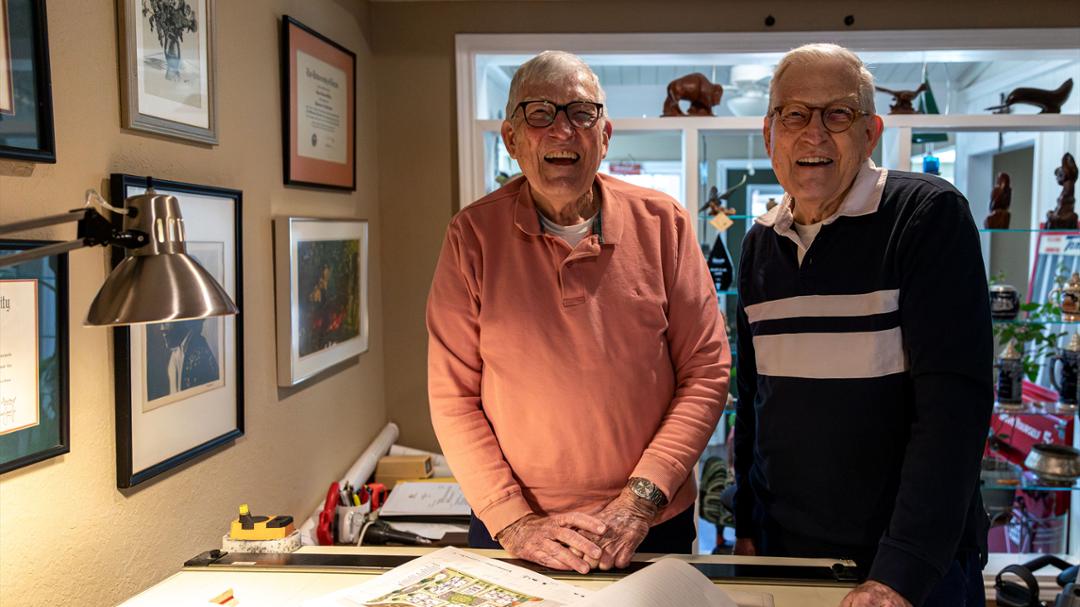Jim and John White have a legacy of mentorship, mastery, and meaning.
Jim and John White have spent only two of their 90 years apart.
The brothers have a connection beyond being twins: they are both architects, teachers and creators. A lifetime of service to Texas Tech University is special; two lifetimes is rare. Jim and John have a combined 91 years.
Huckabee College of Architecture’s lead donor Chris Huckabee fondly recalls his tutelage under the Whites. Huckabee, for all his present success, was not a strong student when he started college. With a 0.7 GPA and a C in bowling, Huckabee knew he had to get his act together his second semester.
Huckabee transferred from business to architecture and John White was his design studio professor. Unlike business school, Huckabee loved architecture. He had drawn up designs for an observation tower and John gave him a C. Huckabee carried himself to John’s office in a huff, expressing his offense.
“It’s the best project up there!” he insisted.
John suggested they walk to where the projects hung, offering to critique Huckabee’s project personally.
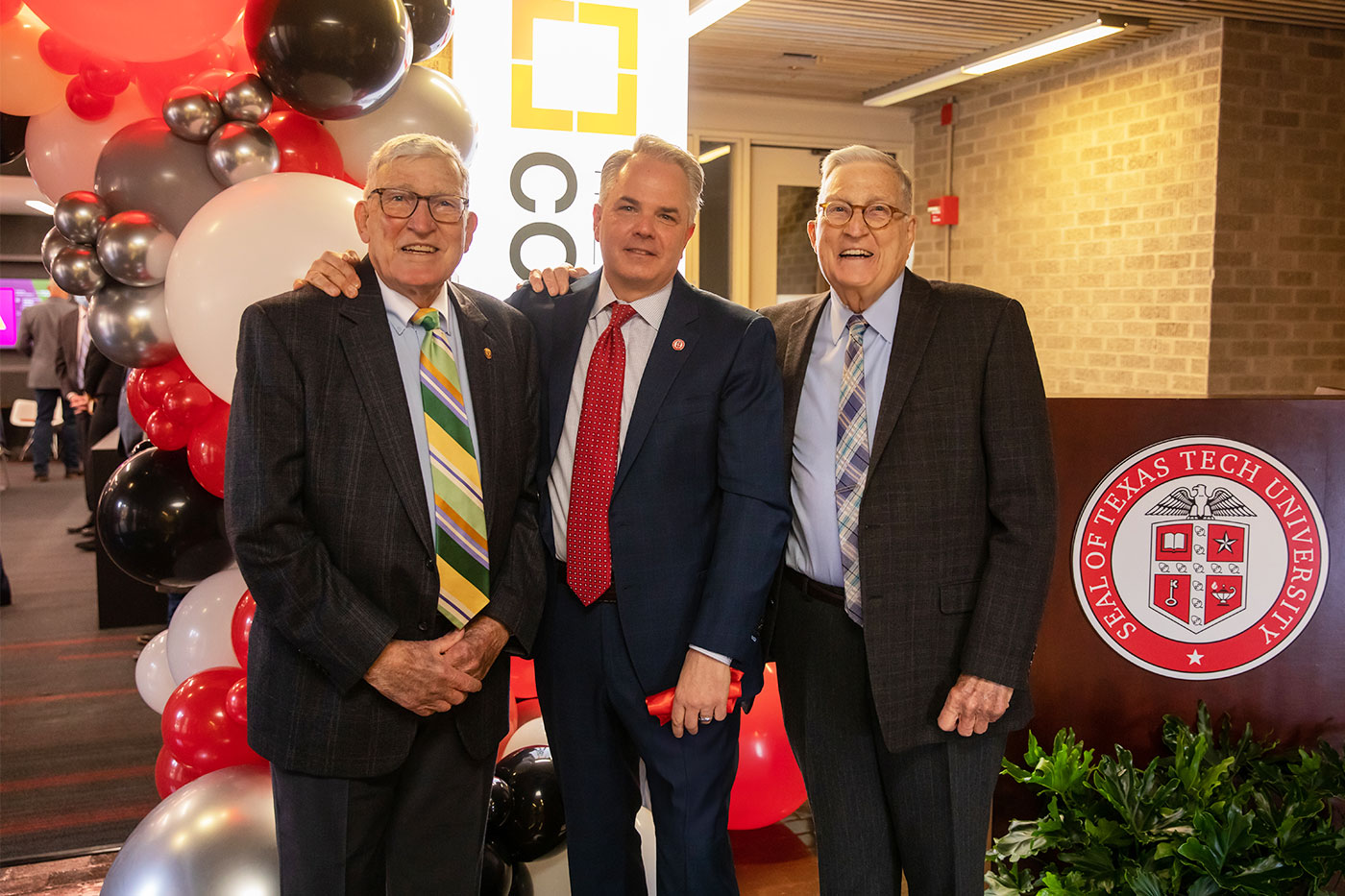
“By the time he finished I was grateful I hadn’t been given an F for the pile of crap I turned in,” Huckabee laughed.
John then said something no one had told Huckabee before.
“You’re too good for this,” John said. “You have too much talent. If you can lighten up a bit, you could become one of the best architects I’ve ever met.”
Huckabee’s life was changed because of the mentorship John offered in that moment, and the future guidance he’d experience from Jim.
There are thousands of architecture alumni who can trace their success back to similar encouragement from Jim and John.
You Have Each Other
The art hanging in both Jim and John’s houses is breathtaking.
Five doors down from one another, they have created their own retreats in retirement. They live a few blocks from campus; close enough to hear the marching band on game days but far enough for peace and quiet.
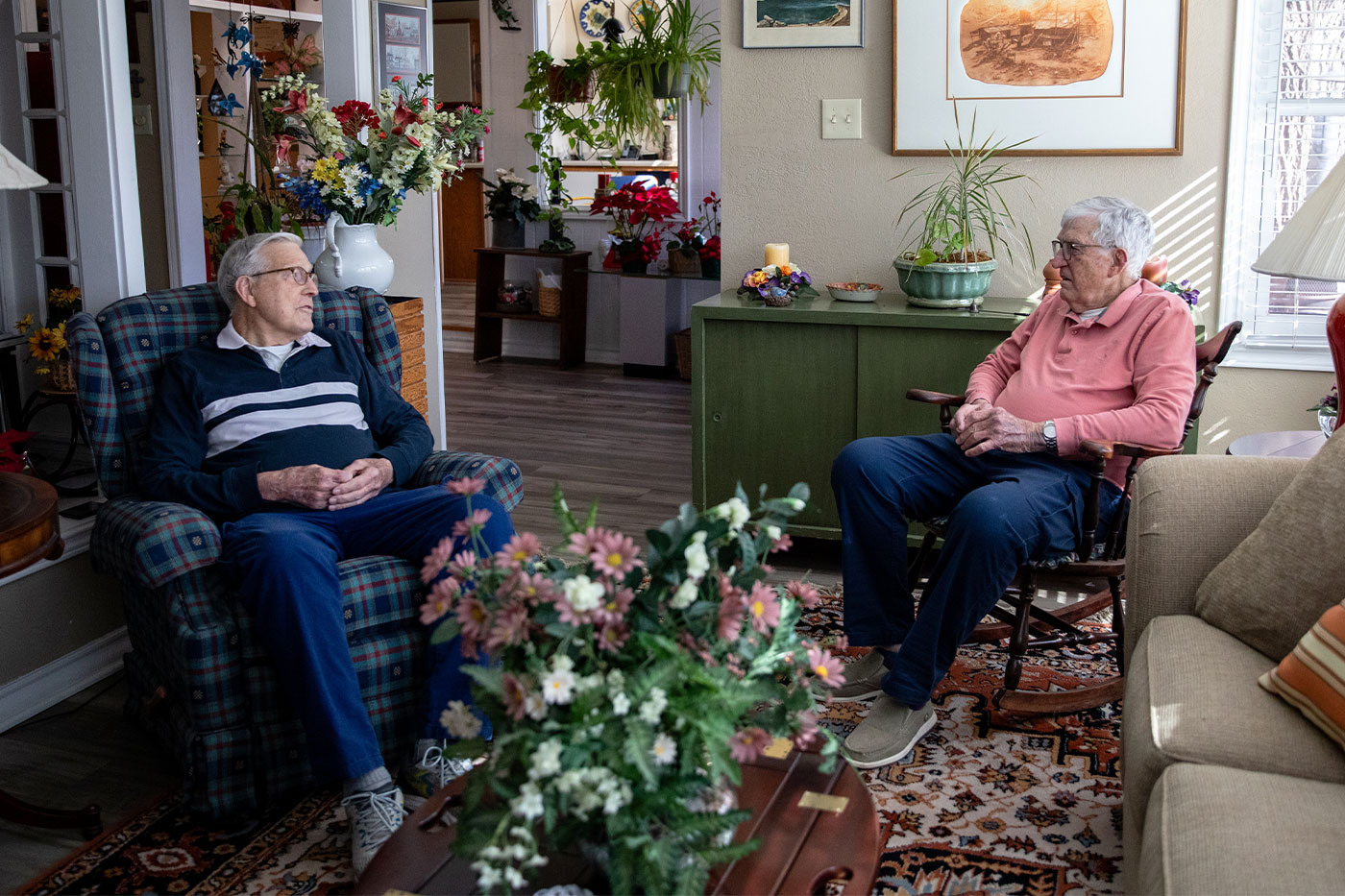
John has various landscapes, portraits, abstract wonders and scenes from around the world on his walls. Each tells a story from a place he’s visited. In one frame sits a humble two-story farmhouse, sketched with pencil by their nephew who also is an architect.
“That’s our grandparent’s home in Anson, Texas,” they said.
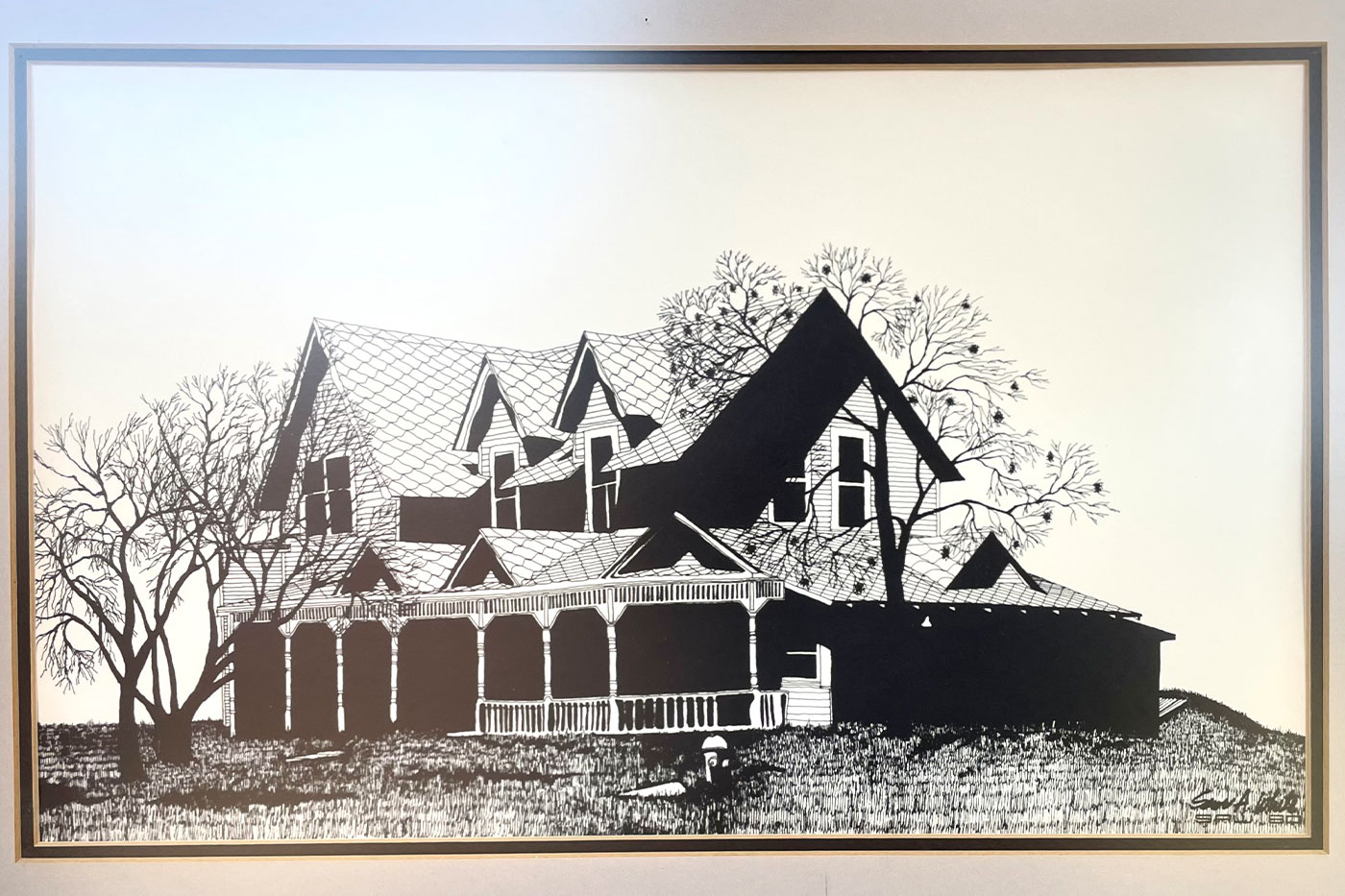
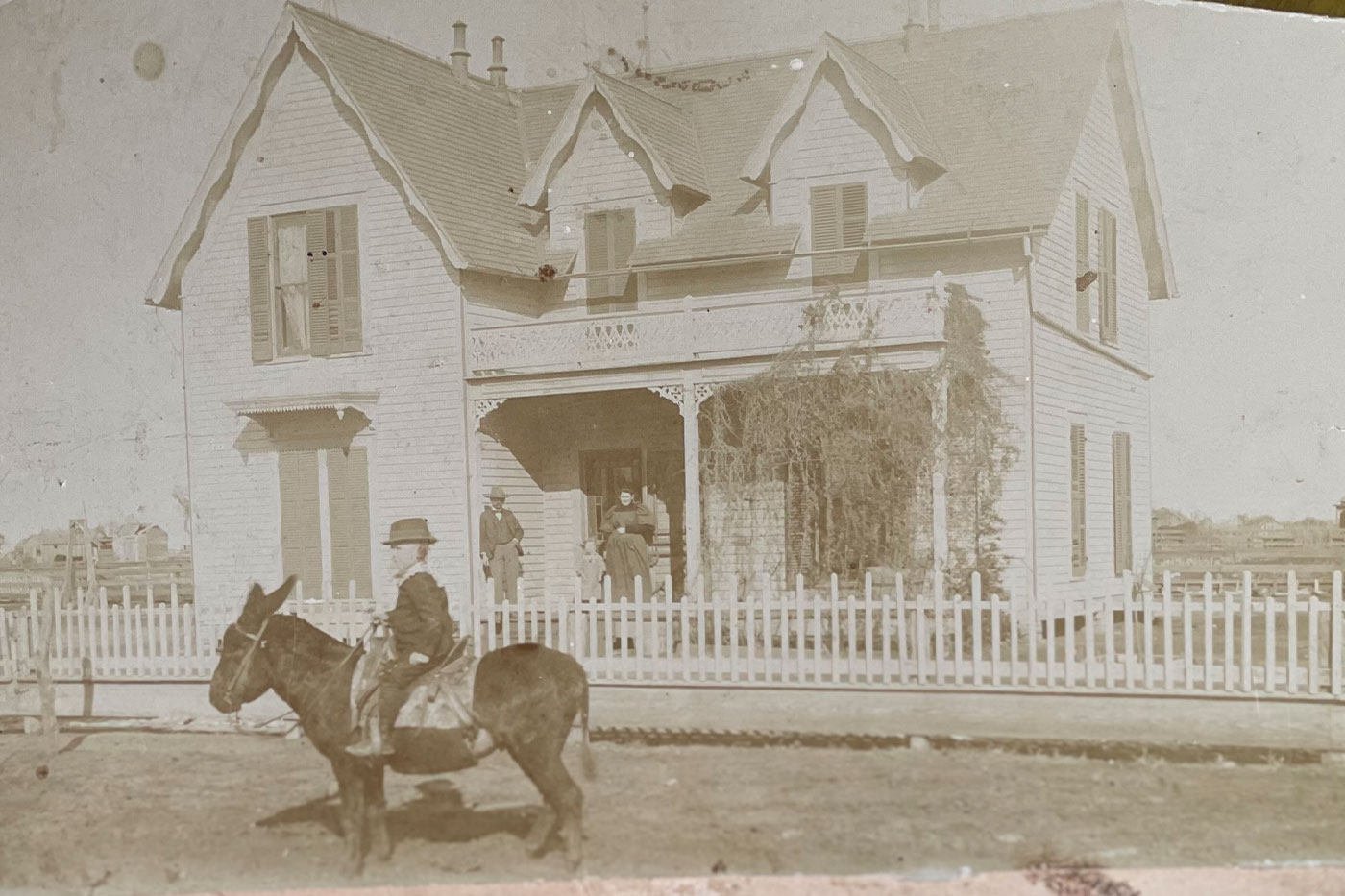
The twins are seated in John’s living room. Both in gray shirts, khakis and tennis shoes; not planned, just the effect of years spent together.
“Just remember I’m the one with circular glasses and Jim has the square ones,” John offers.
The brothers were born and raised in Anson. Both sets of grandparents had settled there years before; one set running a cotton farm, the other running a mercantile.
The twins’ parents married in 1920 after their father returned from WWI.
“He didn’t talk about it much,” Jim said.
Their father came home, put the war behind him, and started a family with their mother. The twins were born in 1933, the youngest of six siblings.
Jim and John recall playing baseball with the neighborhood kids in the empty lot catty-corner to theirs. They remember going to their grandparents’ house, the one in the sketch and sliding down the curved banister, after explicitly being told not to do so.
They remember asking to play with Billy Don from down the street and their mother responding, “You two have each other; how ‘bout you just play in our yard?”
“I think that stuck with us,” Jim said. “Because we’ve done everything together since.”
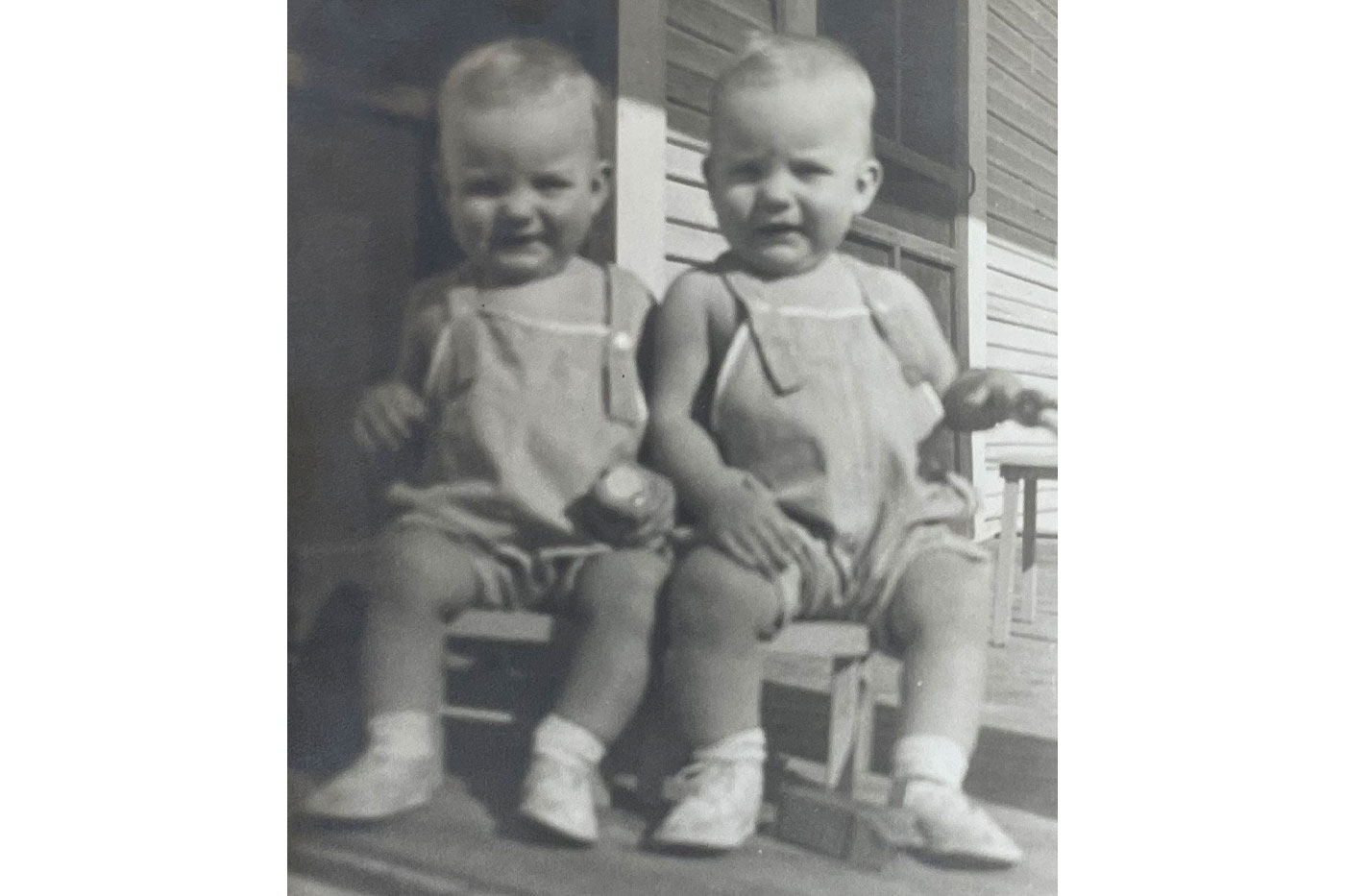
Their grandmother was always putting up and taking down wallpaper in her farmhouse. Moving from one trend to another, trying a different color or texture. This resulted in scraps of leftover paper. The brothers would take the scraps and draw on them until there was no white space left.
“We came from a low-income family, so we did all we could to entertain ourselves,” Jim said.
Their grandmother had a flair for creativity, so she taught the boys how to draw designs. On nice days, the brothers watched new houses being built around town. They’d watch the foundation be laid, frames be erected, and windows installed.
Their next-door neighbor happened to be a building contractor. He entertained the twins’ questions and told them they could have a future in building.
This seemed like a fine idea to the boys.
Then, in seventh grade, their aunt came for a visit. After watching the boys sketch designs, she told them they should consider being architects.
“Well, we’d never heard that word before,” John said.
So as one did in the 1940s, they looked it up in the encyclopedia at their school.
They determined this sounded like an excellent plan. When they got to high school, they told their shop class instructor about becoming architects. Their teacher gave them guidance and taught them how to use all kinds of instruments for measuring, cutting, building and creating. When it came time to tour colleges, he was the one who took the twins.
Jim and John had their heart set on the architectural program at the University of Texas (UT) at Austin, but there was another matter to consider.
“It was a peaceful time, but the draft was still a reality,” John said.
The woman in charge of the draft board in Anson told them they’d need to serve before or after college, but it had to be one or the other.
They had a cousin who’d gone on to be an architect and serve in the Air Force, so that’s what they decided to do. They would obtain their degrees first and then report for duty.
They completed their first year at Arlington State College (now UT Arlington). However, after one year, they came home for the summer and told their mother they would not be returning. They were going to Austin.
“Well, I guess we better visit and find you a place to live,” their mother replied.
Moving Up and Moving Out
The only dormitories on campus at that time were for women. Men either lived at home or in boarding houses. Since they were too far to commute, the twins moved into a boarding house with mostly other students and a few travelers. The house was owned by a widow, and a cook named Thelma prepared three meals a day, other than Sundays.
On Sundays the men were left to fend for themselves. However, the women’s dormitories put on big Sunday suppers and the women could invite a gentleman to be their guest.
All the men hoped for an invite, partially for the company and partially for the free food.
“Things were tight,” the brothers said. “Tuition was $25 a semester, which is a joke now, but it was a substantial amount of money in 1951.”
When tuition was raised to $60 in 1953, they were beside themselves.
Jim and John were hired as the boarding house managers, giving them a break on rent which certainly helped balance out the tuition increase.
They fully gave themselves to their education. The brothers were fascinated by the projects, lectures and experiences they had during their undergraduate years. When their fifth year ended, their four years of service was their next step.
Luckily for the twins, they were able to use their architectural education in their service.
They were deployed to Chanute Air Force Base in Rantoul, Illinois.
Jim and John designed new barracks and classrooms. The base itself became their mission, making it as functional as possible for all who were stationed there. In another time, they might have been deployed abroad, but luckily for the twins, they had just missed the Korean War and they got out a few months before the Bay of Pigs.
In addition to their architectural duties, John was on the funeral detail.
“That was a sobering experience,” he recalled. “Whenever an airman was killed in battle, they were sent home and we would oversee the funeral.”
The memory of family members’ faces on the worst day of their lives is still something John remembers with clarity.
Another memory of their time on base was the friendships they made.
“We spent a lot of time with a Lieutenant and his wife,” Jim said. “In fact, we’ve stayed friends with them ever since. We exchange Christmas cards every year.”
Jim and John’s Christmas card list is very long.
When the end of their service arrived, they were thrilled to find an architecture firm and start doing the work they’d always dreamed of doing.
Odessa
The plan was to move to Dallas, but the economy was on a downturn and few firms were hiring. One of Jim and John’s friends told them they should consider heading to the Permian Basin. The economy might have been struggling, but oil was booming.
The brothers were hired by the same firm. They had many projects, but mostly focused on designing public schools since there was steep demand. With so many families moving to Midland-Odessa to make their money in oil, there was an influx in school enrollments.
Jim and John made Odessa their home for the next decade. They became involved in their community by attending the Methodist Church, serving on various boards, volunteering and hosting ice cream socials at their house every Friday night, sometimes wine if it was too cold for ice cream.
One event they always loved was the Architects’ Annual Golf Tournament. Hundreds of architects and even some pro-golfers would come out to raise money for scholarships.
Jim remembers planning the tournament. They wanted to make sure there was food and entertainment for the golfers at the end of the day.
So, in came Frank Sinatra and Dean Martin with their timeless grins and a few packs of cigarettes. The duo attended the tournament for a few years, flown in to bring more folks out for the cause.
“I never got to talk to either of them,” Jim lamented, “But I did meet professional golfer Byron Nelson and he gave me some pointers on my swing.”
Even with the likes of Sinatra and Martin around, Jim and John were voted “Odessa’s Most Eligible Bachelors” in the mid-sixties. A photo of the twins ran in the newspaper, creating a stir around town.
A young woman named Wanda took note and ended up meeting the brothers at the Methodist Church’s Salad Supper, a meal the church put on for the new teachers in town.
“I met Jim that night,” Wanda said. “I thought he was a good-looking fellow and ended up attending a Sunday school class he and John were in.”
Wanda was a Baptist, but all it took was a Salad Supper and a suitor to lure her into the Methodist tradition. Jim and Wanda were married in 1970; John was their best man.
One year into their marriage, Jim got a phone call from a friend in Lubbock.
“It was Professor Nolan Barrick, who’d been a faculty member at UT in Austin and was now the chair of architecture at Texas Tech,” Jim said. “He needed more faculty because the department was growing. He told me he needed someone with my background in an architectural office.”
Jim politely turned Barrick down, content with his newlywed life in Odessa. But Nolan kept calling. He explained that the department was moving into a brand new 10-story building and would become its own division.
The opportunity turned in Jim’s mind, becoming more intriguing.
He talked to Wanda, and they decided he would go ahead to Lubbock. She had already signed a teaching contract for the school year. If it turned out to be a good fit, she’d join him the following summer.
Wanda packed up their things the following summer and they never looked back.
Meanwhile, John decided to attend graduate school. There was no graduate program in architecture at Texas Tech at the time, so it meant saying goodbye to Jim for the first time in 32 years. He attended the University of Nebraska and earned his master’s in architecture. While it separated the twins for two years, it also made them realize they had no interest in being apart again.
After his time in Lincoln, John was positioned for pretty much any job he wanted. He never imagined becoming a teacher with Jim. He thought maybe he would move to Lubbock and find a firm to work at. But the architecture division was still growing and there was a need for more instructors at Texas Tech.
John decided he’d take a position with the university. Neither of them knew the journey they were about to depart on.
Texas Tech
Barrick told Jim he would need a master’s degree to teach, but he would arrange for Jim to pursue this opportunity while teaching. Since Texas Tech didn’t offer an architectural graduate program until 1985, Jim pursued a master’s degree in parks and recreation planning from what is now the Davis College of Agricultural Sciences & Natural Resources.
“I believe landscape architecture and architecture go hand-in-hand, they’re very connected,” Jim said. “It was nice to get my second degree in an area I’d always had been interested.”
Jim was an instrumental partner in developing the defense for the Division of Architecture to become an independent college and this was accomplished in 1985.
While Jim was busy working full time and also running an architectural office, John found a new passion of his own.
At the end of his first-year teaching, John was figuring out what to do for the summer. He thought he’d do some consulting work for a firm in town, since there were not summer classes to teach.
One day, John sat down for lunch with a fellow faculty member who shared an idea.
“Why don’t you go work for the Historic American Building Survey (HABS),” he suggested.
John inquired what the group did and how his experience would be relevant. He discovered that HABS was part of the National Park Service and documented historic structures all around the country.
A history buff, John’s interest was piqued.
After a few phone calls, the HABS offered John a summer position as a project supervisor. He’d have a small team of students to help survey, and their summer location would be in Cheyenne, Wyoming.
John surveyed historic sites every summer for the next 25 years. His work even took him to Puerto Rico, where he surveyed a fort built by the Spaniards in 1539. Chris Huckabee was on that trip.
“I loved it,” John said. “It gave me a chance to travel and experience things I never would have done otherwise.”
John has visited almost every state in the country, and some foreign countries along the way as his expertise became sought after by many in the historic preservation community. If you go to the Library of Congress, you’ll find 60,000 drawings John and his team have completed.
John also went on to create the historic preservation program at the Huckabee College of Architecture. Today, the program houses the leading voices on the topic throughout Texas.
Meanwhile, Jim was busy helping then-dean Martin Harms equip the college for a tidal wave of change.
The two of them conversed on the number of hours the Bachelor of Architecture degree program required and the possibility of converting it to a Master of Architecture. The five-year bachelor program was equivalent to a master’s in other professional degree programs.
They pursued that idea, and it was approved by the Texas Higher Education Coordinating Board and became the first five-year Master of Architecture program in the nation in 1995.
During the intervening years of Harms and Jim working on this program, Harms submitted his resignation and recommended Jim to be the interim dean of the college. Jim accepted and then implemented the program.
The college took the necessary steps to begin its nationwide search for its next permanent leader.
As the 1990s rolled in, computers were changing many fields of study, but arguably none so much as architecture. What had been done exclusively by hand with pencils, rulers and paint was suddenly possible with a computer.
“Our building was made of concrete,” Jim said. “So, when we decided to wire the classrooms, we had to build false beams into the elevator shafts to get the wiring from one side of the building to another.”
At first it was a few computers, the exception to the rule. After a few years, it became clear that incoming students expected to be trained in the new software. Wanting their students to have every competitive advantage, the college’s administration decided to shift to teaching design primarily on computers.
One morning during Jim's tenure as interim dean, Provost John Burns called Jim into his office.
“Jim, sit down I want to talk to you,” he said.
“What can I do for you?” Jim asked.
“I’ve been talking to the faculty, and they don’t want a search. They want you,” Burns said. “What do you want to do?”
“What do you mean?” Jim asked.
“Well, you won’t get to teach much if you become dean,” Burns said. “You’ll be expected to sit in a lot of meetings and put your foot down if necessary. Does that appeal to you?”
Jim had not considered such a role, but the college needed a leader and he had been asked for by name.
“I’ll do it for five years,” Jim said. “After that, I’m going back to the classroom.”
Jim was appointed dean in September 1997 and served in that capacity until 2002. Enrollment went up by 17% under Jim’s leadership, and invaluable faculty members were hired, one of whom is the college’s current dean, Upe Flueckiger.
“When I arrived, Jim was deeply committed to making the college the best it could be,” Flueckiger said. “Both Jim and John are curious people, and that rubbed off on everyone around them, especially students.”
Jim and John's curiosity is what led them to one of the milestones of their professional career.
At the turn of the century, the college was ready to invest in new technology. There was a high-tech laser scanner that could measure buildings and landmarks from all angles. Jim knew it would be invaluable for research and recruitment.
He took a meeting with university president David Schmidly and Burns.
“We showed them what the scanner could do,” Jim said. “We brought the scanner equipment in and had it scan everyone in the room. It put a complete profile together on each person, including Schmidly.”
The presentation was a success, and since the Texas Tech University System was starting its first capital campaign, no one could blame them for dreaming big. After the college obtained the scanner, John mentioned the acquirement to a colleague with the HABS.
“Well, how’d you like to scan the Statue of Liberty?” John’s colleague asked.
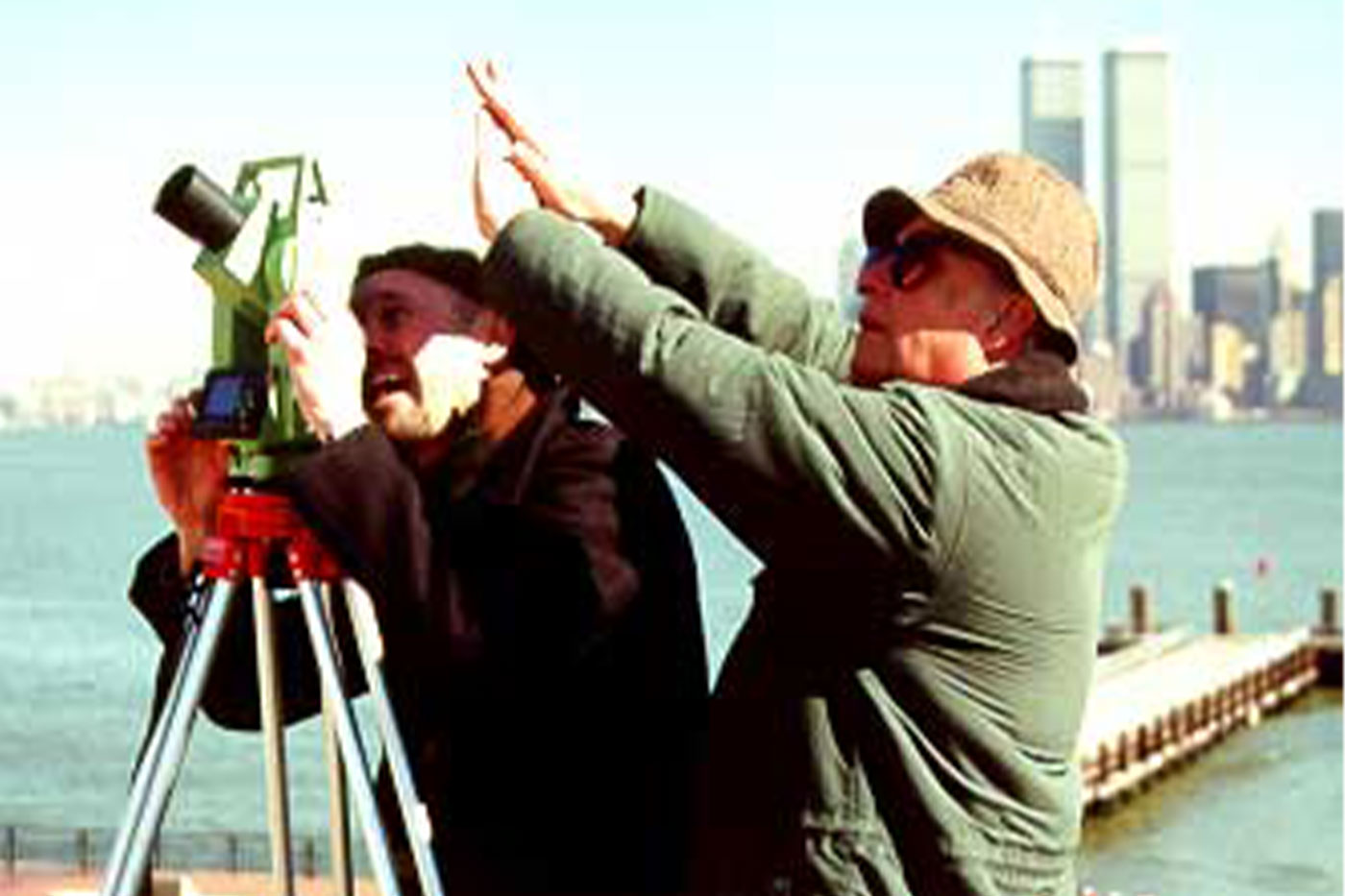
The National Park Department was looking to hire a team to collect data on the monument. The statue posed a daunting maintenance task, not knowing exactly what was where. They needed a map to show where each little nut and bolt was. They needed an incredibly detailed drawing that no one could provide until this technology came along.
Texas Tech got the job. The team consisted of John White, John Burns, Glenn Hill, Elizabeth Louden and five students.
“Schmidly was very pleased,” John smiled.
The whole country became fascinated by the project, with an article appearing on the front page of the New York Times. News of the project spread internationally, with publications picking it up in Tokyo and Rome. The team arrived on site in August of 2001. They had a monumental feat before them, quite literally. Even though the scanner could capture 800 points-per-second, the sheer size of the statue would create months, if not a year’s worth of work.
One month into the project, progress halted.
Protecting History
“I may have the last picture of the Twin Towers taken from the Statue of Liberty,” John said.
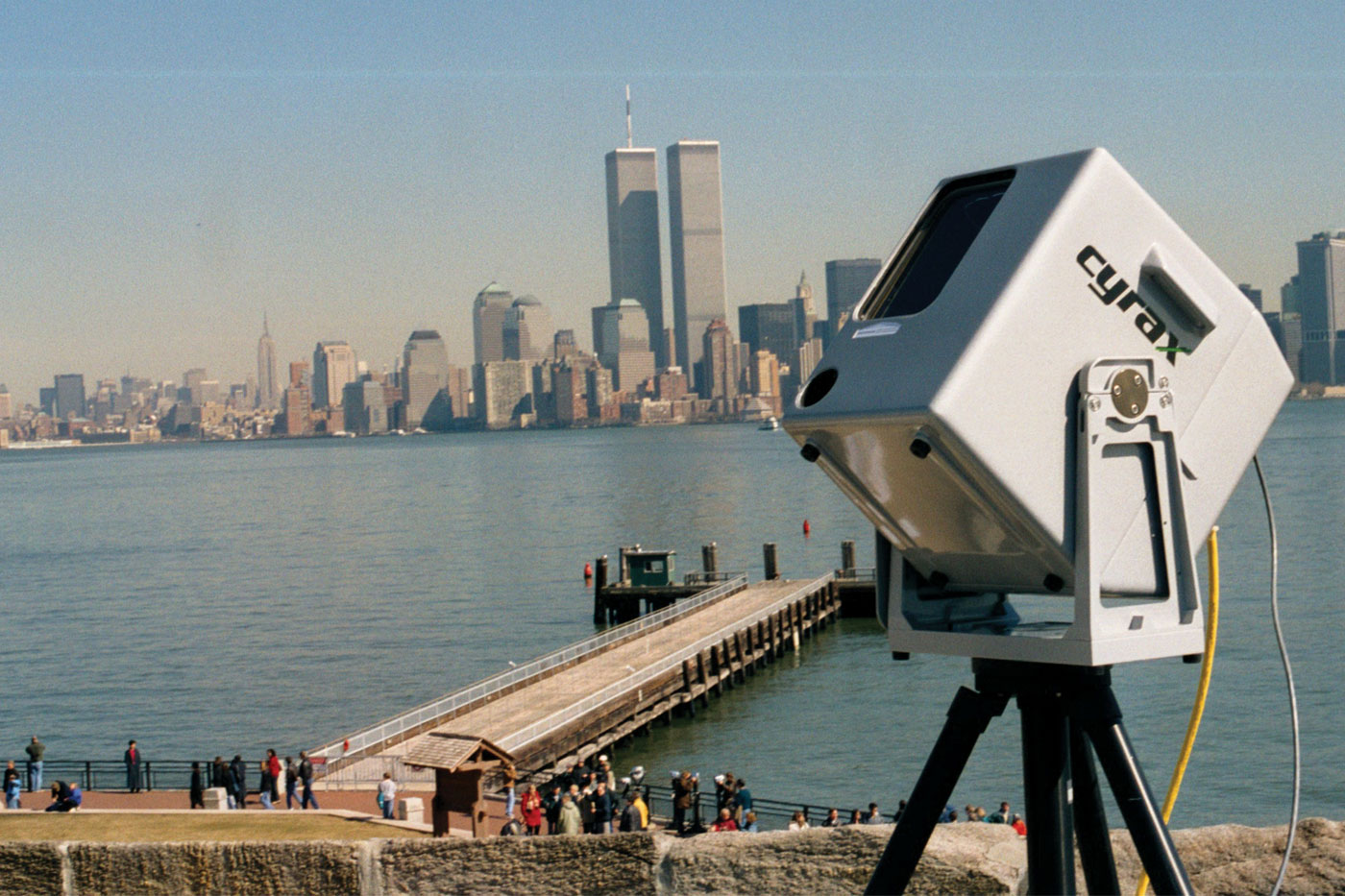
The project was paused for years in the aftermath of 9/11. But when the work picked back up, it was more important than ever. What started for mere maintenance reasons morphed into something more.
The government now wanted the drawings so that if the iconic landmark were ever destroyed, it could be replicated.
The team returned in 2006 and spent a year collecting the data. Working around a 225-ton object with limited positions to collect from proved to be quite a challenge, but in the end, they got it done.
After John’s team processed the last of the 16 million data points, the project became an example, replicated on Mount Rushmore, Hearst Castle and countless other national treasures.
In Kenneth Chang’s New York Times article, he says, “There are an uncountable number of photographs of the Statue of Liberty, but no drawings that record the depth of each fold in her gown, the width of her eyes, the curve of each finger clasping her tablet.”
Thanks to the White brothers and Texas Tech, no detail of Lady Liberty will ever be lost.
Looking Back
Over their time at Texas Tech, Jim and John taught second-year design studios, fourth-year design studios, thesis courses, an environmental site planning course, masonry construction, and countless others. In fact, it would be hard to find a course that neither taught at some time or another.
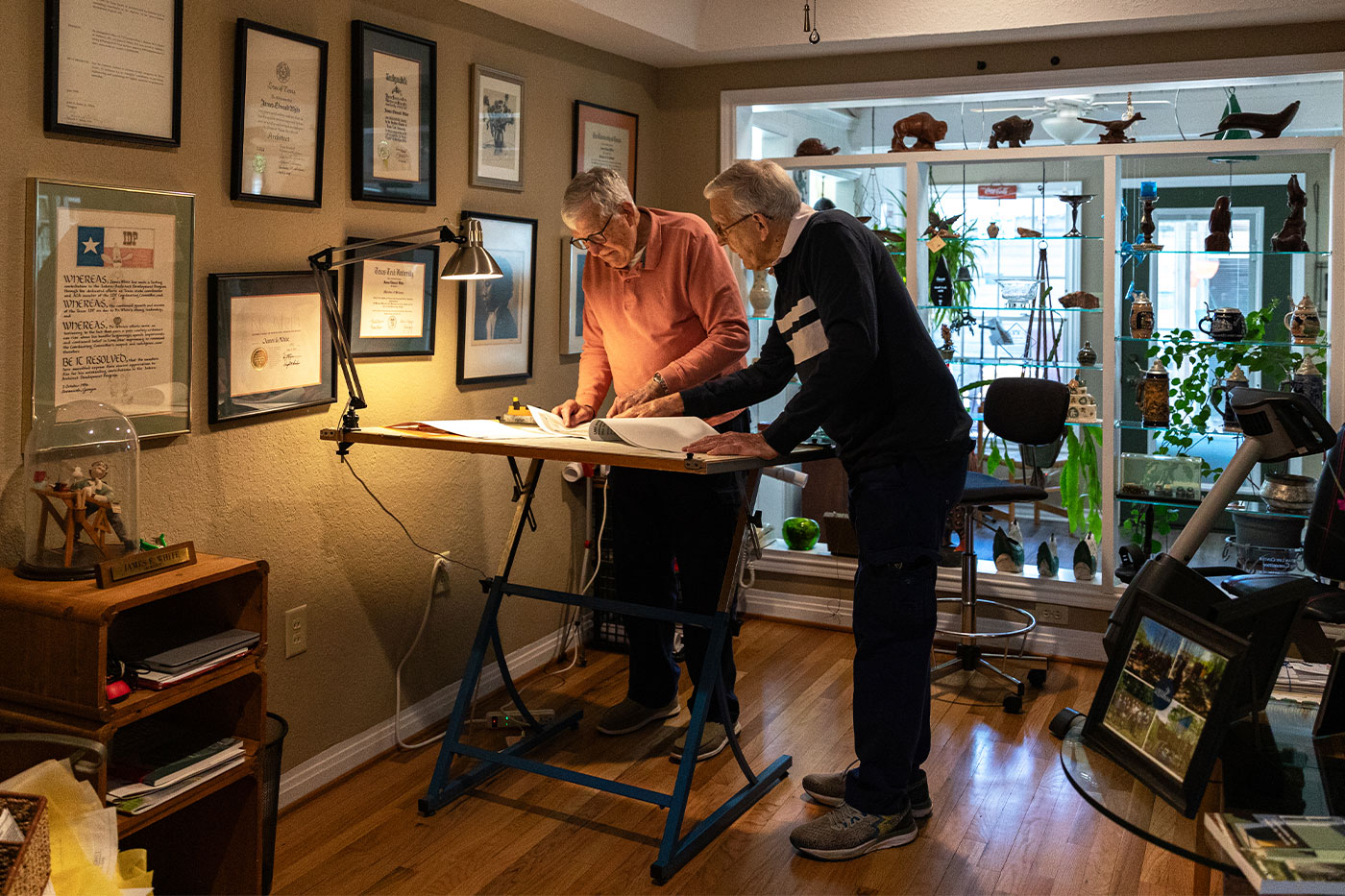
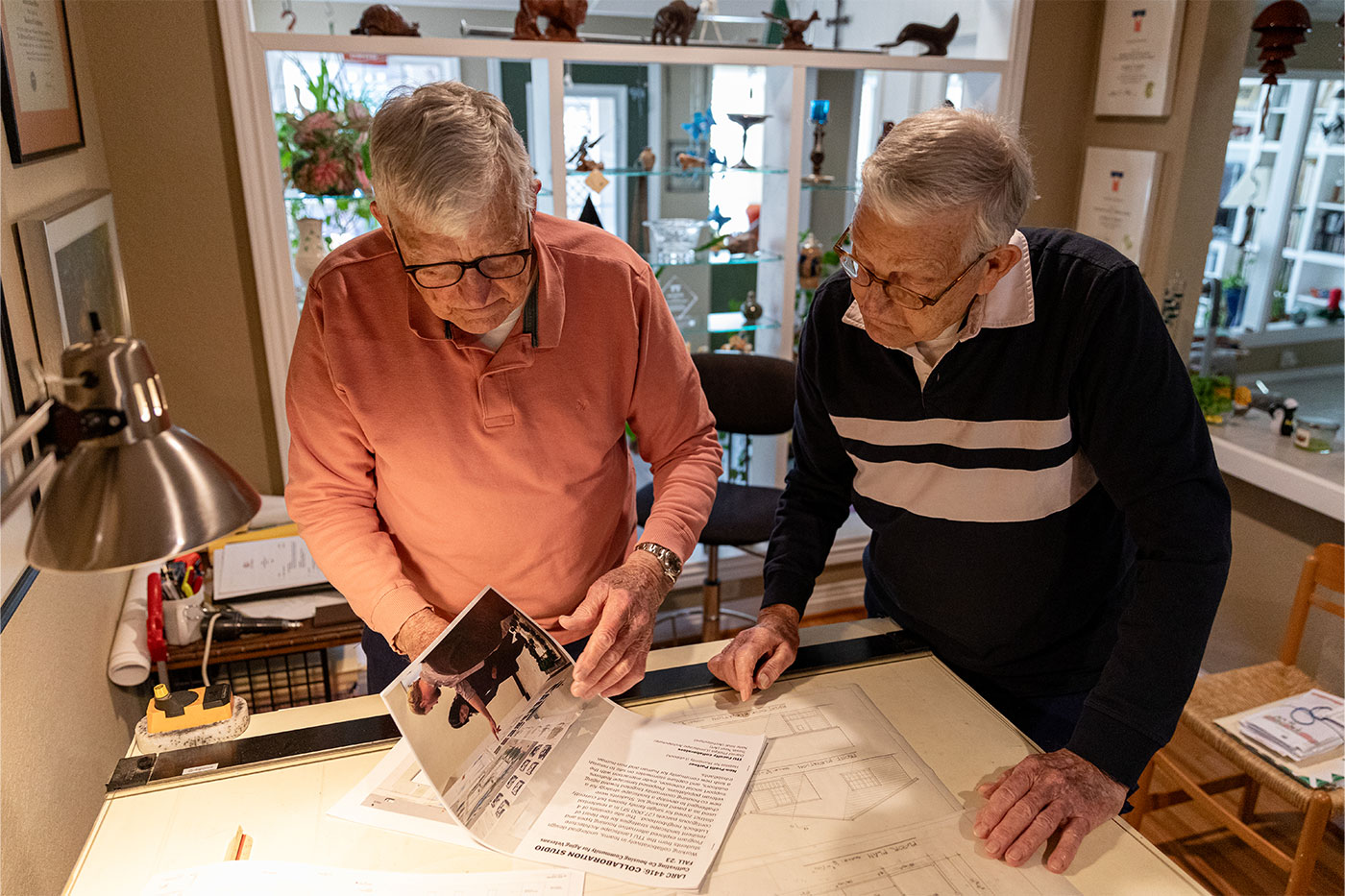
“I have sat on many thesis committees with John,” Flueckiger said. “He is a gifted thesis critic.”
And like Chris Huckabee, most students do not feel “critiqued” after coming in front of Jim or John. They feel encouraged.
“Everyone deserves a chance, and even a second chance,” Jim said, John shaking his head in agreement. “Sometimes it’s hard to walk the line between compassion and fairness, but I find it’s more intuitive than many think.”
The brothers both say they knew when a student needed a helping hand.
“I knew of some faculty who would not accept a late submission, no exceptions,” Jim said.
One semester, Jim had a student come to his office on the final day of class and tell him he wouldn’t be able to put his project up on the wall. The student’s eyes fixed on the floor, unable to meet Jim’s.
“My wife just left me,” the student said.
Jim sat there in silence for a moment.
“I’ll review your project when it’s ready,” he replied.
Jim and John both say the students who got second chances rarely wasted them. Rather, they became the most successful alumni of the college.
Of course, the brothers also had their fair share of students who were just not cut out for the profession. The college’s incoming class is usually 300 in size, with half that number gone by the second year, but usually elsewhere within the university.
“We don’t see that as failure,” Jim said. “That means we’re doing our job in educating students, which first and foremost means helping them discover who they are.”
Jim and John retired in 2018, at the age of 85. Their retirement party, hosted at Jones AT&T Stadium had more than 500 people in attendance.
Flueckiger says that impact reverberates on.
“You can’t talk to an alumnus from our school and get through a conversation without them asking, ‘How are Jim and John?’
Everyone loves them, and although they’re retired, they’re part of our family.”
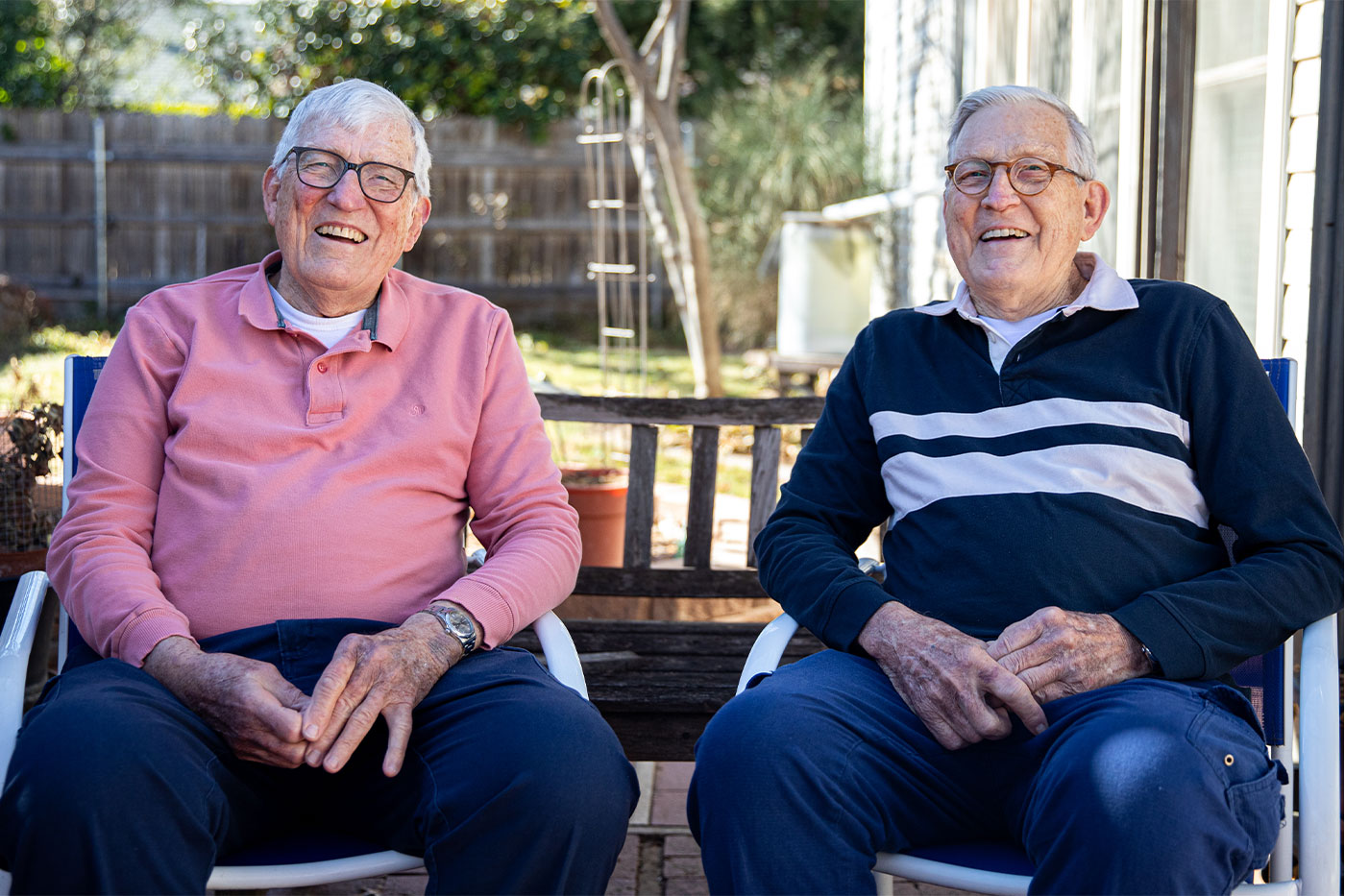
The college hosts a lecture series once a month and every time, the brothers are in the front row. They come to hear what has changed in the profession they love so much. Sometimes the guest speakers are former students.
This was the case in September of 2023 when Chris Huckabee came back to campus. He talked about the successful firms he was running, and the pro-bono work his team had done. He told students how to dream audaciously and embrace the changes coming their way with artificial intelligence.
Then he looked to the front row, to the identical heads of white hair, and said, “But if I can give you one piece of advice, it’s to find a mentor and be a mentor. That’s what Jim and John did for me. They changed my life.”
Editor's Note:This article has been updated to correct information published in a previous version. In that version, Jim White's recounting of a conversation with Provost John Burns was cited as a conversation between White and former Dean Martin Harms.
We apologize for the error and strive to correct our mistakes as quickly as possible.

